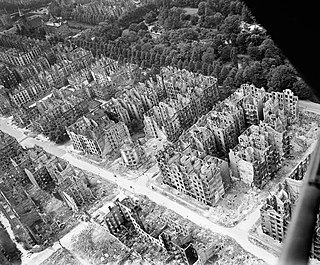
The Allied bombing of Hamburg during World War II included numerous attacks on civilians and civic infrastructure. As a large city and industrial centre, Hamburg's shipyards, U-boat pens, and the Hamburg-Harburg area oil refineries were attacked throughout the war.
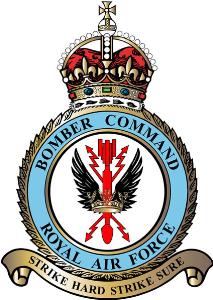
RAF Bomber Command controlled the Royal Air Force's bomber forces from 1936 to 1968. Along with the United States Army Air Forces, it played the central role in the strategic bombing of Germany in World War II. From 1942 onward, the British bombing campaign against Germany became less restrictive and increasingly targeted industrial sites and the civilian manpower base essential for German war production. In total 501,536 operational sorties were flown, 2.25 billion pounds of bombs were dropped and 8,325 aircraft lost in action. Bomber Command crews also suffered a high casualty rate: 55,573 were killed out of a total of 125,000 aircrew, a 44.4% death rate. A further 8,403 men were wounded in action, and 9,838 became prisoners of war.
The Pathfinders were target-marking squadrons in RAF Bomber Command during World War II. They located and marked targets with flares, at which a main bomber force could aim, increasing the accuracy of their bombing. The Pathfinders were normally the first to receive new blind-bombing aids such as Gee, Oboe and the H2S radar.
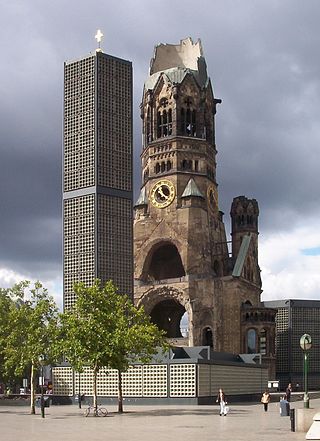
Berlin, the capital of Germany, was subject to 363 air raids during the Second World War. It was bombed by the RAF Bomber Command between 1940 and 1945, the United States Army Air Forces' Eighth Air Force between 1943 and 1945, and the French Air Force in 1940 and between 1944 and 1945 as part of the Allied campaign of strategic bombing of Germany. It was also attacked by aircraft of the Red Air Force in 1941 and particularly in 1945, as Soviet forces closed on the city. British bombers dropped 45,517 tons of bombs, while American aircraft dropped 22,090.3 tons. As the bombings continued, more and more people fled the city. By May 1945, 1.7 million people had fled.

The German city of Cologne was bombed in 262 separate air raids by the Allies during World War II, all by the Royal Air Force (RAF). A total of 34,711 long tons (35,268 t) of bombs were dropped on the city, and 20,000 civilians died during the war in Cologne due to aerial bombardments.

The bombing of Augsburg in World War II included two British RAF and one USAAF bombing raids against the German city of Augsburg on 17 April 1942 and 25/26 February 1944.
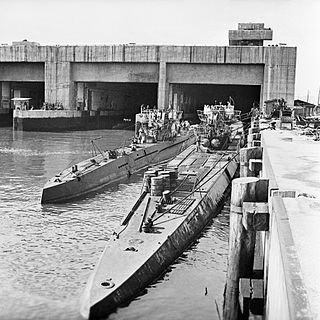
A submarine pen is a type of submarine base that acts as a bunker to protect submarines from air attack.

In the early hours of 15 October 1944, No. 5 Group of the Royal Air Force (RAF) carried out the most destructive of 42 attacks on Braunschweig (Brunswick) during World War II. The attack was a part of Operation Hurricane, which was designed to demonstrate the capabilities of the Allied bombing campaign. It caused a massive conflagration that developed into a firestorm, and resulted in Braunschweig, the city of Henry the Lion, burning continuously for two and a half days from 15 to 17 October. More than 90 percent of the medieval city centre was destroyed.

The Area Bombing Directive was a directive from the wartime British Government's Air Ministry to the Royal Air Force, which ordered RAF Bomber Command to destroy Germany's industrial workforce and the morale of the German population, through bombing German cities and their civilian inhabitants.

Darmstadt was bombed a number of times during World War II. The most devastating air raid on Darmstadt occurred on the night of 11/12 September 1944 when No. 5 Group of the Royal Air Force (RAF) bombed the city. 66,000 of the 110,000 inhabitants of Darmstadt at the time became homeless. Darmstadt lost between 12,500 and 13,500 inhabitants during World War II. The calligraphic memorial Darmstädter Brandnamen lists about 4,000 names. Darmstadt had several major industrial targets including Merck and Rohm and Haas chemical works as well as military communications networks.
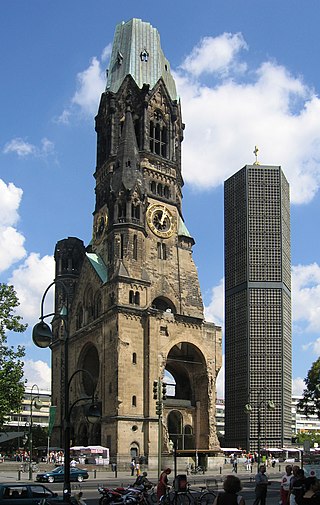
The Battle of Berlin was a bombing campaign against Berlin by RAF Bomber Command, along with raids on other German cities to keep German defences dispersed and which was a part of the bombing of Berlin during the strategic bombing of Germany in the Second World War. Air Chief Marshal Arthur Harris, Air Officer Commanding-in-Chief (AOC-in-C) Bomber Command, believed that "we can wreck Berlin from end to end if the USAAF come in with us. It will cost us between 400 and 500 aircraft. It will cost Germany the war".
The bombing of Stuttgart in World War II was a series of 53 air raids that formed part of the strategic air offensive of the Allies against Germany. The first bombing occurred on August 25, 1940, and resulted in the destruction of 17 buildings. The city was repeatedly attacked over the next four and one-half years by both the RAF and the 8th Air Force as it had significant industrial capacity and several military bases, and was also a center of rail transportation in southwestern Germany. Stuttgart endured 18 large-scale attacks by the Royal Air Force (RAF) during the war, during which 21,016 long tons (21,353 t) of bombs were dropped on the city, but the RAF concluded that its attacks against Stuttgart were not as effective as they could have been:
Stuttgart's experience was not as severe as other German cities. Its location, spread out in a series of deep valleys, had consistently frustrated the Pathfinders and the shelters dug into the sides of the surrounding hills had saved many lives.

Duisburg was bombed a number of times by the Allies during World War II. The most devastating air raids on Duisburg occurred during October 1944 when the city was bombed by the Royal Air Force (RAF).

During World War II, the city of Lübeck was the first German city to be attacked in substantial numbers by the Royal Air Force. The attack on the night of 28 March 1942 created a firestorm that caused severe damage to the historic centre, with bombs destroying three of the main churches and large parts of the built-up area. It led to the retaliatory "Baedeker" raids on historic British cities.

To carry out the planned V-1 "flying bomb" attacks on the United Kingdom, Germany built a number of military installations including launching sites and depots. Some of the installations were huge concrete fortifications.

The Bombing of Bremen in World War II by the British Royal Air Force (RAF) and US Eighth Air Force involved both indiscriminate "area bombing" and, as capacity improved, more targeted raids upon the city's military-industrial facilities. These included the shipyards of Vulkan, AG Weser and Atlas Werke, the Valentin submarine pens, oil refineries and the aircraft works of Focke-Wulf.
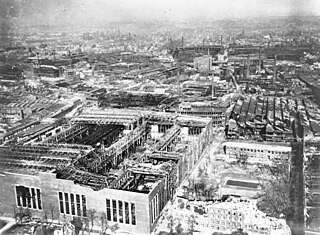
The Battle of the Ruhr was a strategic bombing campaign against the Ruhr Area in Nazi Germany carried out by RAF Bomber Command during the Second World War. The Ruhr was the main centre of German heavy industry with coke plants, steelworks, armaments factories and ten synthetic oil plants. The British attacked 26 targets identified in the Combined Bomber Offensive. Targets included the Krupp armament works (Essen), the Nordstern synthetic oil plant at Gelsenkirchen and the Rheinmetall–Borsig plant in Düsseldorf, which was evacuated during the battle. The battle included cities such as Cologne not in the Ruhr proper but which were in the larger Rhine-Ruhr region and considered part of the Ruhr industrial complex. Some targets were not sites of heavy industry but part of the production and movement of materiel.
The Wilhelmshaven World War II bombings by the Allies of World War II destroyed targets at Wilhelmshaven in Germany. From spring 1943 until November 1943 slave labourers of the SS-Baubrigade II from the Neuengamme concentration camp were transferred to Wilhelmshaven to clear up after air raids.
The term "thousand-bomber raid" was used to describe three night bombing raids by the Royal Air Force against German cities in summer 1942 during World War II. The term was a propaganda device, whereby Arthur Harris reached the number of bombers by including not only bombers that were currently operational as part of RAF Bomber Command, but also aircrews from Operational Training Units to accumulate a force of 1,000 bombers as a demonstration of the RAF's power. The bulk of the bomber force was twin-engined medium bombers like the Vickers Wellington. While the number of heavy bombers in the RAF increased, greater tonnage could be dropped on a target with fewer aircraft. Later mass RAF raids used between 400 and 700 four-engined bombers, and on some nights, Bomber Command sent two forces of 400-bomber each to separate targets. Operation Gomorrah in 1943 and the Attack on Dresden in 1945 each used nearly 800 aircraft. Nearly 900 were sent to Berlin in February 1944; with aircraft on other missions that night more than 1,000 bombers were active, but 1,000 bombers were never sent against a single target after June 1942.















